KSEEB Solutions for Class 8 Science Chapter 1 Crop Production And Management Points To Remember
Crop: When plants of the same kind are grown and cultivated in one place on a large scale, it is called a crop. In India, crops can be broadly categorised into two types based on seasons- Rabi and Kharif crops.
Basic practices of crop production:
1)Preparation of Soil: One of the most important tasks in agriculture is to turn the soil and loosen it. The process of loosening and turning of the soil is called tilling or ploughing.
2)Sowing: Sowing seeds at appropriate depths and distances gives a good yield. A good variety of seeds is sown after the selection of healthy seeds. Sowing is done by seed drills.
3)Adding Manure and Fertilisers
Fertiliser: Chemical substances that are rich in nutrients and essential for plant growth. The inorganic compounds contain nutrients such as nitrogen, potassium and phosphorus. They are made in factories. Examples: Urea, ammonium sulphate, potash, etc.
Manure: A natural substance prepared from the decomposition of plant and animal wastes (cow dung, animal bones, dead leaves, dead insects and vegetable wastes) by the action of microbes.
4)Irrigation: The supply of water to crops at appropriate intervals is called irrigation.
Method of Irrigation: Tradition methods of Irrigation: Moat, Chain pump, Dhekli, Rahat.
Modern methods of Irrigation: Sprinkler system, Drip system.
5)Protection from Weeds: Weeding involves the removal of unwanted and uncultivated plants called weeds.
6)Harvesting: Harvesting is the cutting of the mature crop manually or by machines.
7)Storage: Proper storage of grains is necessary to protect them from pests and microorganisms. Large-scale of storage of grains is done in silos and granaries to protect them from pests like rats and insects. Farmers store grains in jute bags or metallic bins. Food is also obtained from animals for which animals are reared. This is called animal husbandry.
Agriculture: The practice of growing plants and rearing animals on a large scale for food, fibre and other useful products.
Class 8 Science KSEEB Crop Production Notes
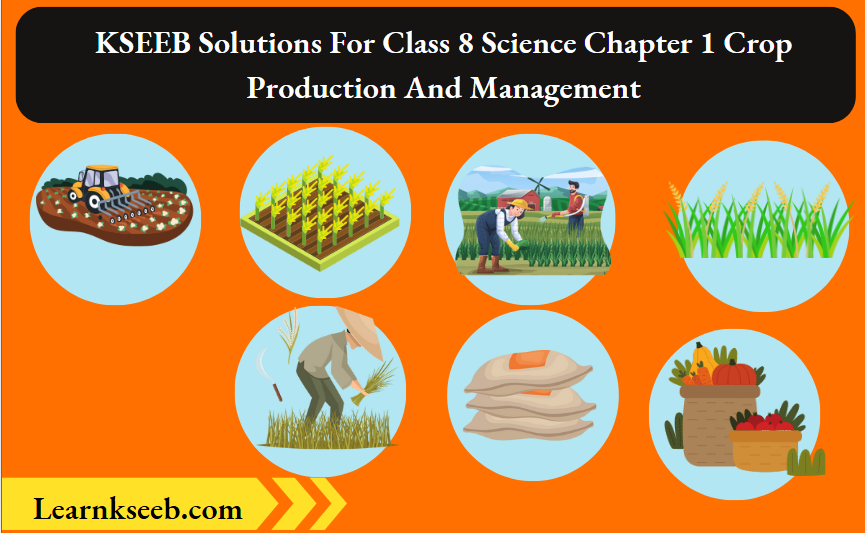
Crop Production And Management Ncert Textbook Exercises
Question 1. Select the correct word from the following list and fill in the blanks.
float, water, crop, nutrients, preparation
1)The same kind of plants grown and cultivated on a large scale at a place is called______
2)The first step before growing crops is_______of the soil.
3)Damaged seeds would _______on top of the water.
4)For growing a crop, sufficient sunlight_____ and_____ from the soil are essential.
Answer: crop, preparation, floats, water, nutrients
KSEEB Solutions For Class 8 Science Chapter 1 Crop Production And Management PDF
Question 2.Match items in column A with those in column B.
A
1)Kharif crops
2)Rabi crops
3)Chemical fertilisers
4)Organic manure
B
(a) Food for cattle
(b) Urea and phosphate
(c) Animal excrement, cow dung, urine and plant waste.
(d) Wheat, gram, pea
(e) Paddy and Maize
Answer: 1)-(e) 2)-(d) 3)-(b) 4)-(c)
Question 3. Give two examples of each
1) Kharif crop
2) Rabi crop
Answer:1) Kharif crop: Paddy and Maize
2) Rabi crop: Wheat and gram
Question 4. Write a paragraph in your own words on each of the following:
Answer:
(1) Preparation of soil: Soil preparation is necessary before growing a crop. It involves tilling and loosening the soil. This allows the roots to penetrate deep in the soil and to breathe easily even when they are deep.
(2) Sowing: The process of putting seeds into the soil is called sowing. The tool used traditionally for sowing seeds is funnel-shaped. Nowadays, a seed drill is used for sowing with the help of tractors. This tool sows the seed uniformly at a proper distance and depth.
(3) Weeding: Some undesirable plants grow along with crops and these unwanted plants are weeds. The process of removing these unwanted plants is called weeding.
(4) Threshing: The process of separating the grain seeds from the chaff is called threshing.
Question 5. Explain how fertilisers are different from manure.
Answer:
Fertilisers:
- A fertiliser is an inorganic salt
- A fertiliser is prepared in factories
- A fertiliser does not provide any humus to the soil.
- Fertilisers are very rich in plant nutrients like nitrogen, phosphorus and potassium
Manures:
- Manure is a natural substance obtained from dung, human waste and plant residues.
- Manure can be prepared in the fields.
- Manure provides a lot of humus to the soil.
- Manure is relatively less rich in plant nutrients.
Karnataka Board Class 8 Science Chapter 1 Solutions
Question 6. What is irrigation? Describe two methods of irrigation which conserve water.
Answer: The artificial method of watering plants for assisting in their growth is called irrigation.
Two methods which help us to conserve water are:
1) Sprinkler irrigation system: This system has an arrangement of vertical pipes with rotating nozzles on the top. It is more useful in uneven and sandy land where sufficient water is not available.
2) Drip irrigation system: This system has an arrangement of pipes or tubes with very small holes in them to water plants drop by drop just at the base of the root. It is very efficient as water is not wasted at all.
Question 7. If wheat is sown in the Kharif season, what would happen? Discuss.
Answer: Wheat crop is sown from November/Decem- ber to March/April. It is grown in winter and requires less water. If wheat is sown in the Kharif season, its production will be decreased considerably.
Question 8. Explain how soil gets affected by the continuous plantation of crops in a field.
Answer: Continuous plantation of crops makes the soil poorer in certain nutrients from the soil. The soil becomes infertile. It does not get enough time to replenish the nutrients.
Question 9. What are the weeds? How can we control them?
Answer: The undesirable and unwanted plants which grow naturally along with the crop are called weeds. The growth of weeds can be controlled by adopting many ways. Tilling before sowing crops helps in the uprooting and killing of weeds, which may then dry up and get mixed with the soil. Weeds are also controlled by using certain chemicals called weedicides. Weedicides are sprayed in the fields to kill the weeds.
KSEEB Class 8 Science Solutions For Crop Production And Management
Question 10. Arrange the following boxes in the proper order to make a flow chart of sugarcane production.
Sending crops to sugar factory – 1
Irrigation-2
Harvesting – 3
Sowing-4
Preparation of soil-5
Ploughing the field – 6
Manuring-7
Answer:
Preparation of soil – 1
Ploughing the field-2
Sowing-3
Manuring – 4
Irrigation – 5
Harvesting – 6
Sending crops to sugar factory – 7
Question 11. Complete the following word puzzle with the help of the clues given below.
Answer:
Down
1. Providing water to the crops.
2. Keeping crop grains for a long time under proper conditions.
3. Certain plants of the same kind grow on a large scale.
Across
1. A machine used for cutting the matured crop.
2. A rabi crop is also one of the pulses.
3. A process of separating the grain from the chaff.
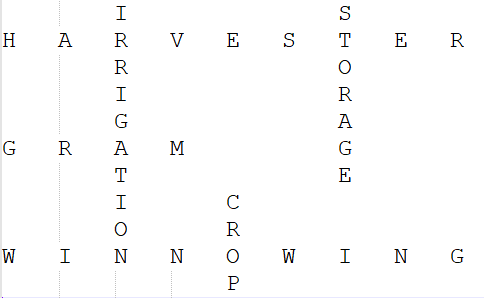
Crop Production And Management Class 8 KSEEB Solutions With Answers
Crop Production And Management Activities
Question 1. Take a beaker and fill half of it with water. Put a handful of wheat seeds and stir well. Wait for some time.
Answer: We observe that most of the seeds sink while some float on water. Damaged seeds become hollow and lighter so they float. In this way, we can separate damaged seeds from healthier ones.
Question 2. Jake moong or gram seeds and germinate them. Select three equal-sized seedlings out of these. Now take three empty glasses or similar vessels. Mark them A, B and C. To glass, A add little amount of soil mixed with a little cow dung manure. In the glass, B put the same amount of soil mixed with a little urea. Take the same amount of soil in glass C without adding anything Now pour the same amount of water into each glass and plant the seedlings in them. Keep them in a safe place and water them daily. After 7 to 10 days observe their growth
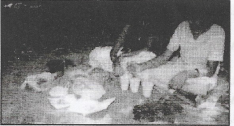
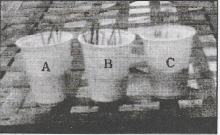
Answer: After 7-10 days we observed that the growth was fastest in glass B followed by glass A. Glass C showed mini-mum growth.
Question 3. Make the following Table in your notebook and complete it.
S.no Food Sources
1. Milk
2. Meat
3. Egg
4. Honey
Answer:

Crop Production And Management Additional Questions
Question 1. What is the basis for the classification of crops in our country?
Answer: In our country, crops are classified on the basis of the season in which they grow.
Question 2. Name the tool used for tilling the soil
Answer: Aplough
Question 3. Why should loose soil be levelled?
Answer: Loose soil should be levelled for sowing and irrigation.
Question 4. How is ploughing done these days?
Answer: Nowadays, ploughing is done by a tractor have- ing a multi pronged plough
Question 5. Why should grains be dried before storage?
Answer: Grains should be dried before storage to remove the excess moisture in them so that microbes are not able to attack the grains.
Crop Production And Management Class 8 KSEEB Questions And Answers
Question 6. Name the methods applied for weeding.
Answer:
- Manual method
- Chemical method
- Biological method
Question 7. What are the advantages of manure?
Answer: Following are some advantages of manure:
- It enhances the water-holding capacity of the soil.
- It improves soil quality.
- It promotes the growth of soil-friendly microbes.
- It is renewable, biodegradable and eco-friendly.
Question 8. What are weedicides? Give some examples.
Answer: Weedicides are chemicals that are used to remove weeds. Some commonly used weedicides are 2, 4-D and metaphor.
Question 9. What is ploughing or tilling? State its advantages.
Answer: The process of loosening and turning the soil is called tilling or ploughing. This is done by using a plough. Ploughs are made of wood or iron.
The following are the advantages of ploughing or tilling:
- Ploughing loosens the soil and makes it aerated.
- It helps in mixing organic matter with the soil uniformly.
- It initiates the growth of natural agents and microorganisms and thus, keeps the soil fertile.
- It increases the water-holding capacity of the soil.
- It helps in the easy penetration of roots into the soil.
KSEEB Class 8 Science Crop Production And Management Exercise Solutions
Question 10. Write a short note on the terms:
1) Storage
2) Harvesting
Answer:
1)Storage: Storage of produce is an important task. If the crop grains are to be kept for a longer time, they should be safe from moisture, insects, rats and microorganisms. Before storing, the grains are properly dried in the sun to reduce their moisture in them. This prevents attack by insect pests, bacteria and fungi. Grains are stored by farmers in jute bags or metallic bins. However, large-scale storage of grains is done in silos and granaries to protect them from pests like rats and insects.
2)Harvesting: After the maturation of the crop, harvesting is an important task. In harvesting, crops are pulled out or cut close to the ground. It usually takes 3 to 4 months for a cereal crop to mature. Harvesting in our country is either done manually by sickle or by a machine called a harvester. sowing seed also depends upon the seed size.
Question 11. Why the depth at which seeds are planted is important?
Answer: If the seed is planted too deep then it will not get enough sunlight to germinate. If the seed is planted too shallow then it will not get enough soil to support germination. The depth for sowing seeds also depends upon the seed size.
Question 12. Why is it advisable to wash fruits and vegetables before using them?
Answer: Because fruits and vegetables may contain many pesticides, used during crop production practices, on them along with other germs and dust.
Question 13. What is a plough?
Answer: A plough is equipment for ploughing. It is mainly made of a wooden shaft called a plough-shaft, attached to a triangular iron blade called a ploughshare.
Question 14. Name any two fertilisers.
Answer: NPK, Diammonium phosphate
Question 15. What is the process of separation of grain from chaff called?
Answer: Winnowing
Crop Production And Management Multiple Choice Questions
Question 16. Which one of the following conditions is not essential to grow maize?
1) High temperature
2) Humidity
3) Low temperature
4) Rainfall
Answer: 3) Low temperature
Explanation: Maize is grown in a warm and tropical climate. The optimum temperature for growing maize is between 18°c -27 °c during the day and 14-15°c at night. Hence a cold climate is not essential to grow maize.
Karnataka Board 8th Science Chapter 1 Important Questions And Answers
Question 17. Propagation of ginger is generally done using
1) Seed
2) Stem (rhizome)
3)Root
4) Leaf
Answer: 2) Stem (rhizome)
Question 18. Which of the following statement is not true for organic manure?
1) It enhances the water-holding capacity of the soil.
2) It has a balance of all plant nutrients.
3) It provides humus to the soil.
4) It improves the texture of the soil.
Answer: 2) It has a balance of all plant nutrients.
Explanation: Organic manure is obtained by the decomposition of plants and animal waste which makes the soil nutrient-rich. But it does not mean that organic manure provides all the nutrients in the required amount hence option 2) is wrong.
Question 19. The term used for the process of separation of grains from the chaff is
1) Sieving
2) Threshing
3) Winnowing
4) handpicking
Answer: 3) Winnowing
Explanation: Winnowing is a process used to separate grains from the chaff by removing the scaly inedible chaff surrounding the grain. A machine called Combine is used for this process. The combine is a mixture of a harvester and a thresher.
Explanation Of Crop Production And Management In KSEEB Science
Question 20. Read the statements given below.
1) Seeds require moisture for germination.
2) Plants can absorb nutrients mostly in dissolved form.
3) Irrigation protects crops from both frost and hot air currents.
4) Irrigation improves soil texture. Choose the combination of statements which indicate the need to irrigate crops.
1) 1 and 2
2) 1, 2, 3
3) 1, 2, 3, 4
4) 1, 3
Answer: 1) 1 and 2
Explanation: Irrigation supplies water to the crops when required and this will help the seed germinate by providing moisture to the seed. Plants readily absorb nutrients along with water in a dissolved form.
Question 21. Which of the following tools would a farmer use to remove weeds from the field?
1) Hoe
2) Plough
3) Axe
4) Cultivator
Answer: 1) Hoe
Explanation: Hoe is used to remove weeds and to loosen the soil. He works like a blade. Axe is used to cut trees. Plough is used for tilling the soil. The cultivator is used for ploughing.
Question 22. Which of the following is not true for fertilisers?
1) They increase the yield.
2) Their excessive use disturbs the balance of nutrients in the soil.
3) They are generally used in small quantities.
4) They are environment-friendly.
Answer:4) They are environment-friendly.
Explanation: Fertilisers are chemical substance that is rich in particular nutrients. Fertilizers indeed help in yield increase. But the long-term and excess usage of fertilizers will reduce soil fertility and pollutes the water bodies. By seeing through the rain.
Question 23. Given below are statements about the harmful effects of weeds on crop plants.
1) They interfere with harvesting.
2) They help crop plants to grow healthily.
3) They compete with crop plants for water, nutrients, space and light.
4) They affect plant growth. Choose the correct combination of statements.
(1) 1, 3, 4 (3) 3, 4
(2) 3 only
(4) 1, 2, 3, 4
Answer: (1) 1, 3, 4
Explanation: Weeds are unwanted plants that grow along with the grown crops. They compete for nutrients, water and sunlight with crops thereby affecting the health of crops and the yield.
KSEEB Class 8 Science Chapter 1 Textbook Solutions
Question 24. The process of loosening and turning of soil is called
(1) Irrigation and manuring
(2) Digging and winnowing
(3) Tilling and ploughing
(4) Harvesting and storage
Answer: (3) Tilling and ploughing
Explanation: Tilling and ploughing are the first steps in preparing the land for cultivation. Ploughing is done by using a plough which is made of either wood or iron.
Question 26. The monsoon season in our country is during the months
1) April to December
2) June to September
3) November to March
4) January to May
Answer: 2) June to September
Question 27. The system of irrigation wherein water is supplied drop by drop near the roots of plants, is called
1) Pulley system
2) Drip system
3) Sprinkler system
4) Lever system
Answer: 2) drip system
Explanation: Pulley system is a traditional irrigation method where water is lifted from wells or other water sources and crops are watered. This is done by using the pulley chain and human labour or animals.
The perpendicular pipes, having rotating nozzles on top, are joined to the main pipeline at regular intervals. When water is allowed to flow through the main pipe under pressure with the help of a pump, it escapes from the rotating nozzles. It gets sprinkled on the crop as if it is raining
The Lever system is a traditional irrigation method where humans or animals are used to lift the water from its source. This is a less efficient irrigation method.
KSEEB Class 8 Science Chapter 1 Important Questions
Question 28. Pick out the odd one from the following words given in the box and give the reason for it. Plough, Seed Drill, Hoe, Chain Pump, Sickle
Answer: The answer is Seed drill. The seed drill is modern equipment used to sow the seeds. Whereas Plough, Hoe, Chain pump and sickle are old and traditional equipment used in agriculture.
Question 29. If you are given a dry piece of land for cultivation what will you do before sowing the seeds?
Answer: Before sowing, seed land should be prepared for cultivation. Tilling and ploughing are the first steps in preparing the land for cultivation. Ploughing is done by using a plough which is made of either wood or iron.
KSEEB 8th Standard Science Chapter 1 Notes And Solutions
Question 30. State whether the following statements are True or False. Correct the false statements.
1) Using good quality seed is the only criterion to get a high yield.
2) Growing different crops in different seasons in the same field will deplete the soil of nutrients.
3) All crop plants are sown as seeds in the field.
4) Cells of root nodules of leguminous plants fix nitrogen.
5) Freshly harvested grains must be dried before storing.
Answer:
1) False: To get good yield appropriate agricultural practice, nutrient water is very essential along with good quality seeds.
2) False: It enriches the soil
3) False: Some crops need transplantation Ex: Ginger
4) False: Bacteria called Rhizobium present in the root nodules of leguminous plants fix nitrogen
Question 31. During which months do farmers grow mustard in India?
Answer: From October to March farmers grow mustard in India.
Question 32. Which activity of the farmer can promote the growth of earthworms and microbes in the field?
Answer: Loosening the soil/maintaining high moisture levels in the soil.
Crop Production And Management Short-Type Answer Questions
Question 1. Beera wants to practice crop rotation in his field. Suggest a Rabi crop and a Kharif crop which will replenish his field with nitrogen. Which crop replenishes nitrogen and why?
Answer:
Kharif: Rice or Soyabean,
Rabi: Pea or Wheat.
Pea/Soyabean are legumes that will fix nitrogen with the help of Rhizobium.
Question 2. Match the agricultural implements given in Column A with their use given in Column B.
Column A Column B
Sickle Ploughing
Hoe Slowing
Seed Drill Harvesting
Sprinkler Irrigation
Answer:
Sickle Harvesting
Hoe Ploughing
Seed Drill Slowing
Sprinkler Irrigation
Question 3. What are organic foods?
Answer: Food crops grown without using any chemicals including fertilizers, weedicides and pesticides are known as organic food.
Step-By-Step Solutions For Crop Production And Management Class 8 Karnataka Board
Question 4. From the word puzzle, Find at least eight words which are farmer’s friends. Classify them into living and non-living.
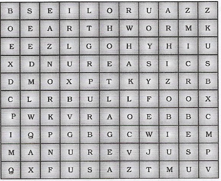
Answer:
- Living: Seed, Earthworm, Rhizobium, Microbes, Ox
- Non-Living: Plough, Urea, NPK, Mature, Hoe.
Question 5. (1)Name the tool used with a tractor for sowing seeds in a field.
(2) What are the advantages of using this tool?
Answer:
1) The seed drill is the tool used with a tractor for sowing seeds in a field.
2) Advantages of seed drill are as follows
- It saves time and labour.
- After sowing seeds are covered by soil which will protect seeds from.
- Seeds are sown at uniform distances and depths. This avoids overcrowding of the seeds in one location.
Simplified Notes For KSEEB Class 8 Science Crop Production
Question 6. (1) Name the practice followed for large-scale rearing of farm animals.
(2) What facilities are provided to farm animals?
Answer:
(1) Animal Husbandry
(2) Animals should be provided with shelter, food and care.
Karnataka State Board Syllabus for Class 8 Textbooks Solutions
- Chapter 1 Crop Production and Management
- Chapter 2 Microorganisms: Friend and Foe
- Chapter 3 Synthetic Fibres and Plastics
- Chapter 4 Materials: metals and Non-Metals
- Chapter 5 Coal and Petroleum
- Chapter 6 Conservation of Plants and Animals
- Chapter 7 Force and Pressure
- Chapter 8 Friction
- Chapter 9 Sound
- Chapter 10 Combustion and Flame
- Chapter 11 Cell Structure and Functions
- Chapter 12 Reproduction in Animals
- Chapter 13 Reaching the age of Adolescence
- Chapter 14 Chemical Effects of Electric Current
- Chapter 15 Some Natural Phenomena
- Chapter 16 Light
- Chapter 17 Stars and the Solar System
- Chapter 18 Pollution of Air and Water
